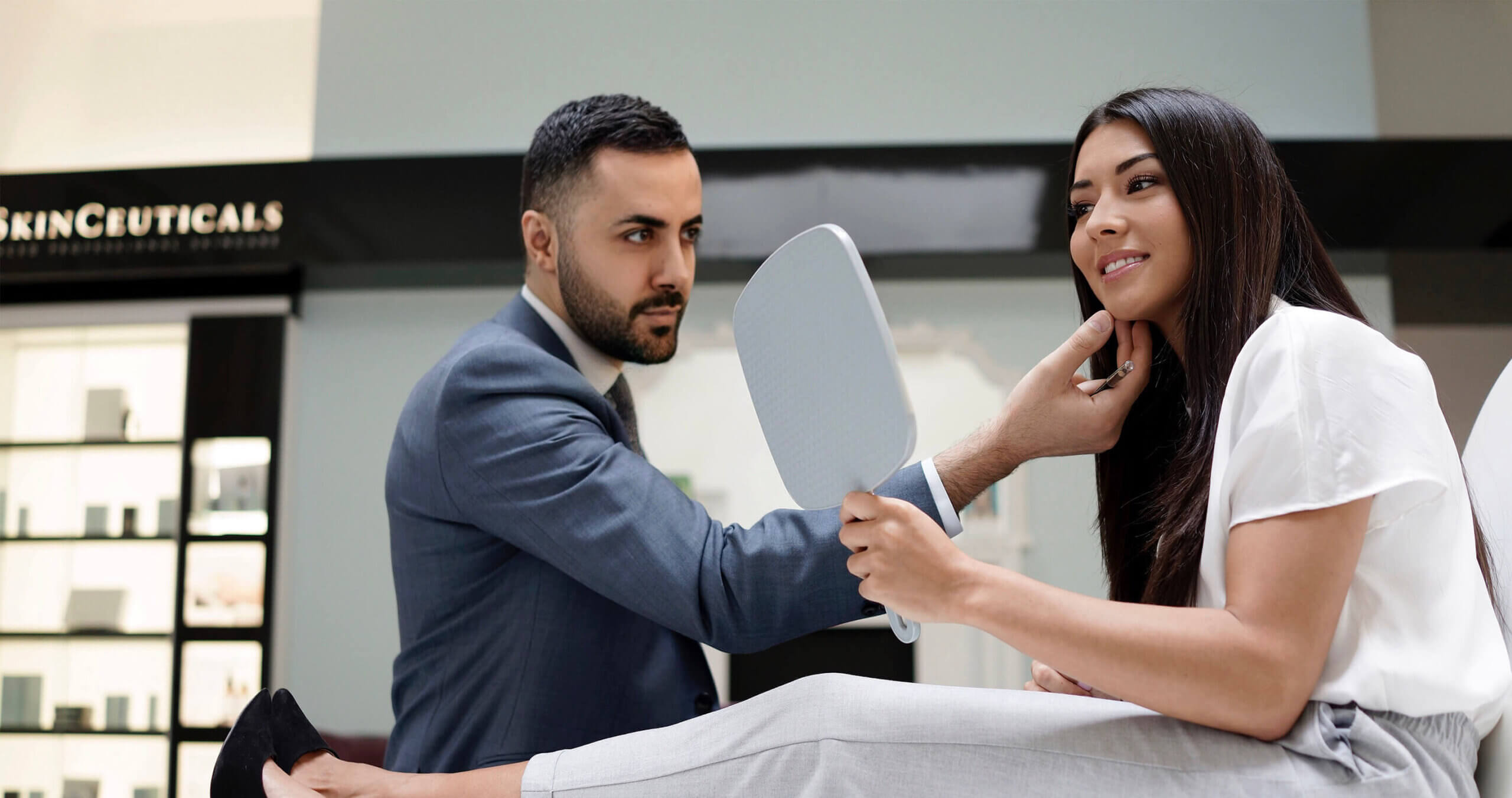A double chin, or submental fullness, is a common concern that affects many individuals regardless of age or body weight. At Sloane Clinic in Harley Street, Central London, we specialise in advanced, minimally invasive aesthetic treatments that are guided by a deep understanding of facial anatomy and scientific evidence. In this in-depth guide, we explore the anatomical causes of a double chin, the importance of precise diagnosis, and the full range of evidence-based treatment options—from chin fillers and advanced fractional radiofrequency microneedling (such as Morpheus8) to FaceTite with submental liposuction.
Understanding the Anatomy of a Double Chin
A double chin can result from multiple contributing factors. A thorough understanding of the underlying anatomy is essential for selecting the most effective and appropriate treatment.
Key Anatomical Components:
- Subcutaneous (preplatysmal) fat: Located just beneath the skin, this layer contributes to volume and smooth contouring. While often targeted in treatment, it must be preserved to a degree to maintain youthful softness.
- Subplatysmal (deep) fat: Found beneath the platysma muscle, this fat is more fibrous and contributes significantly to bulky or resistant double chins.
- Platysma muscle: A thin, sheet-like muscle extending from the jaw to the clavicle. With ageing, it can separate and form vertical bands.
- Bone structure (chin and jaw projection): A recessed chin or weak mandibular angle can make even minimal soft tissue appear more prominent.
According to a cadaveric study by Gassman et al. (2017), the majority of excess fat in the neck region tends to lie within the subplatysmal layer, especially in ageing individuals. Over-aggressive removal of superficial fat risks aesthetic issues like hollowness and skin tethering, particularly when natural subcutaneous padding is lost.
The Importance of Accurate Diagnosis
Before planning any treatment, it is crucial to determine the primary anatomical contributors to the patient’s double chin. Is it predominantly excess fat, skin laxity, or lack of chin projection? Is the fat superficial or deep? Does the platysma exhibit banding?
At Sloane Clinic, we utilise a combination of advanced diagnostic tools to ensure accurate and individualised assessment:
- 3D imaging with Canfield Vectra H2 for full-face analysis, angle measurements, and treatment simulation.
- High-frequency ultrasound imaging to assess fat layer thickness, platysma position, and to identify deep fat or glandular hypertrophy.
- MRI imaging in select cases for in-depth visualisation of soft tissue layers and prior filler placement.
This multi-modal approach ensures we target the right structure and avoid unnecessary or ineffective procedures.
Why a Conservative Approach Matters
A successful double chin treatment isn’t about removing the most fat—it’s about restoring proportion and harmony. Overly aggressive submental liposuction or fat dissolving procedures that destroy subcutaneous fat can produce:
- Skin adhesion and irregularities
- Premature ageing of the neck
- Asymmetry or over-correction
Preservation of the superficial fat layer is essential, especially in ageing patients, as it maintains a youthful and smooth contour. Liposuction should focus selectively on the deeper, more fibrous fat compartments and avoid violating the subdermal plane.
Chin Fillers: Structural Enhancement for Receded Chins
A poorly projected chin can exaggerate the appearance of a double chin, even in lean individuals. In such cases, increasing chin projection with hyaluronic acid (HA) filler is one of the most effective and least invasive interventions.
Clinical Evidence
Studies have shown that increasing chin projection can significantly improve the cervicomental angle (angle between chin and neck). Shimojima et al. (2024) demonstrated that combining cryolipolysis with chin filler improved this angle by an average of 9.3°, compared to 5.1° with fat reduction alone.
Further, MRI imaging by Master et al. (2024) has revealed that HA fillers, particularly in the chin and midface, demonstrate remarkable longevity. In over 33 patients, filler was still detectable via MRI even 2–5 years post-injection, with one case persisting for 15 years.
Our Approach at Sloane Clinic
We use structurally robust HA fillers placed deep to mimic bone and support the soft tissue. Treatment typically takes 30–45 minutes with minimal downtime. Results are immediate, with continued integration over 2–4 weeks. Because of the long-lasting nature of fillers in deep anatomical sites, top-ups are often only needed every 2–3 years and, commonly, become less necessary with time.
Chin fillers are an excellent option for younger patients with good skin tone but weak skeletal support, or as a complementary treatment to fat reduction.
Fractional Radiofrequency Microneedling: Skin Tightening and Subdermal Remodelling
Certain fractional radiofrequency (RF) microneedling procedures (such as Morpheus8) can deliver controlled heat energy beneath the skin surface leading to contraction of the fibroseptal network and remodelling and coagulating the subdermal fat. These devices are also powerful stimulators of collagen and elastin production and care should be taken in their use as excess energy settings can result in scar tissue formation. Consequently, they should always be used by highly trained medical specialists, which unfortunately is often not the case in the UK. It should be noted that only some devices currently available are able to reach the deeper fat compartments as many fractional radiofrequency technologies as limited to the dermis or superficial subcutaneous layers.
Benefits
- Tightens mild to moderate skin laxity
- Smooths textural irregularities
- Reduces small submental fat pockets
- Can be safely repeated for ongoing improvement
Scientific Support
In a study by Hendricks and Farhang (2022), RF microneedling achieved up to 45% soft tissue contraction with minimal side effects. Morpheus8 specifically was highlighted as an effective, minimally invasive tool for early neck ageing and jawline definition.
What to Expect
Treatments are performed in a clinical setting using local anaesthesia. Most patients require 2–3 sessions, spaced 4–6 weeks apart. Results are gradual, developing over several months as collagen builds.
Morpheus8 is particularly effective for:
- Early laxity in the 30–50 age group
- Maintenance post-surgery or liposuction
- Enhancing results of chin filler or FaceTite
FaceTite with Submental Liposuction: Precision Contouring
FaceTite is an advanced RF-assisted liposuction (RFAL) system designed to melt fat and contract tissue simultaneously. When performed correctly, the results of this treatment can be excellent, providing a substantial improvement in the jawline and removal of fatty double chin
How It Works
A thin probe is inserted through a small incision under the chin. Through three tiny incisions under the chin and near the earlobes , we insert a radiofrequency probe to heat (coagulate), emulsify and remodel the fat, contract the fibroseptal network and tightening the overlying skin. The fat is then aspirated with microcannulas (“micro-liposuction”)
Radiofrequency energy is applied internally and externally between bipolar electrodes, emulsifying fat while thermally stimulating collagen production in the dermis and fibroseptal layer.
Indications
- Moderate submental fat
- Mild to moderate skin laxity
- Poor skin retraction potential post-lipo
- Patients desiring significant results without a surgical lift
Limitations
A common issue that we see are surgeons or physicians who use this technology inappropriately. For example, they apply too much energy leading to excessive fibrosis and skeletonisation of the neck due to damage of the subcutaneous fat. Furthermore, FaceTite is not a replacement for a full necklift in patients with severe soft tissue laxity and glandular ptosis. Older or thinner patients who have excessive laxity but little submental fat are not good candidates for this treatment.
Clinical Evidence
Tettamanzi et al. (2024) studied 80 patients treated with FaceTite plus liposuction and reported an average 23 mm reduction in submental projection, high satisfaction, and consistent improvement in neck contour.
Kang et al. (2015) further validated FaceTite’s efficacy, finding 85% of patients rated their results as good or excellent six months after treatment.
Recovery and Results
Downtime is typically 5–7 days. Compression is worn continuously for support for the first 2 weeks and at night for a further 2 weeks. Full results develop over 3–18 months as collagen remodelling occurs. Results often last several years.
At Sloane Clinic, our technique emphasises:
- Preservation of the subcutaneous fat layer
- Avoidance of over-aggressive suction
- Protection of critical neurovascular structures
Why We Don’t Recommend Injectable Fat Dissolving Agents
Injectable deoxycholic acid (Kybella/Belkyra) is marketed for non-surgical fat reduction under the chin. However, its limitations often outweigh the benefits:
Drawbacks
- Requires 2–6 sessions
- Significant swelling after each session
- Pain and risk of skin necrosis
- Marginal mandibular nerve paresis in 2–4% of cases
A case report by Pathoulas et al. (2020) documented persistent nerve injury following deoxycholic acid injection, highlighting potential long-term complications.
Cost Effectiveness
Multiple vials over several sessions make the total cost comparable to FaceTite or liposuction, yet with less precision and potentially less reliable outcomes.
For these reasons, Sloane Clinic does not offer fat dissolving injections and instead focuses on more effective and safer interventions.
Surgical Options: Necklift and Platysmaplasty
In patients with severe skin laxity, prominent platysmal bands, or deep subplatysmal fat and gland hypertrophy, surgical intervention may be necessary.
Necklift and Platysmaplasty
A surgical necklift involves:
- Skin excision and redraping
- Platysma muscle tightening (anterior and/or lateral)
- Excision of deep fat, digastric hypertrophy, or submandibular gland debulking
Platysmaplasty is performed through a submental incision and addresses midline banding and sagging.
Limitations
- Requires general anaesthesia or local anaesthesia with sedation
- More substantial procedure risks, even in expert hands
- Several weeks of recovery
- Permanent scars
- Inevitable tell-tale signs of a full facelift (even if performed by a leading expert)
- Does not prevent future ageing and may require repeat surgery especially if initial procedure was performed at a younger age
- May require revision after several years, with significant variability between patients.
This option is usually reserved for patients in their 50s/60s with more severe soft tissue laxity or those with complex deep neck anatomy that minimally invasive procedures cannot adequately address. While there is an increasing trend to promote facelift/necklift in younger patients on the grounds of better durability of results, we would caution against this as a general approach.
Combining Treatments for Optimal Results
In many cases, the best outcome comes from a combination of modalities. For example:
- Chin filler + Deep fractional radiofrequency microneedling for young patients with weak projection and mild skin laxity
- FaceTite + chin filler for moderate fat and skeletal deficiency
The combination approach allows us to treat fat, tighten skin, and improve skeletal contour without the need for major surgery in most cases.
Mr. Dean Rhobaye: Leading Expert in Minimally Invasive Aesthetics
Sloane Clinic is led by Mr. Dean Rhobaye, an internationally recognised expert in facial aesthetics and reconstructive surgery. With numerous prestigious awards, including the AMWC Aesthetic Award for Best Non-Surgical Facial Beautification, Mr. Rhobaye combines:
- Advanced anatomical expertise
- Experience in facial plastic surgery
- Precision in minimally invasive techniques
Patients can expect a personalised, safe, and artful approach to rejuvenation—without unnecessary surgery or downtime.
Summary: Thoughtful, Individualised Treatment in London
Double chin concerns stem from varied anatomical factors—fat, skin, bone structure, or muscle laxity. At Sloane Clinic, we tailor treatments using:
- Advanced 3D and ultrasound imaging
- Scientific evidence and anatomical precision
- Minimally invasive procedures with long-lasting results
Whether you require subtle augmentation with chin filler, tightening with fractional radiofrequency microneedling, or comprehensive contouring with FaceTite, our goal is to restore natural definition safely and beautifully.
Next Steps
If you’re bothered by submental fullness and want to explore modern, evidence-based treatments, we invite you to schedule a consultation at Sloane Clinic in Harley Street, Central London.
Call us today or book a consultation to begin your personalised assessment and treatment journey.
Simplified References
- Gassman AA et al. Plast Reconstr Surg. 2017.
- Master M et al. PRS Global Open. 2024.
- Shimojima K et al. Clin Cosmet Investig Dermatol. 2024.
- Tettamanzi M et al. Aesthetic Plast Surg. 2024.
- Kang JS et al. Arch Aesthetic Plast Surg. 2015.
- Hendricks AJ & Farhang S. J Cosmet Dermatol. 2022.
- Pathoulas JT et al. Int J Women’s Dermatol. 2020.









